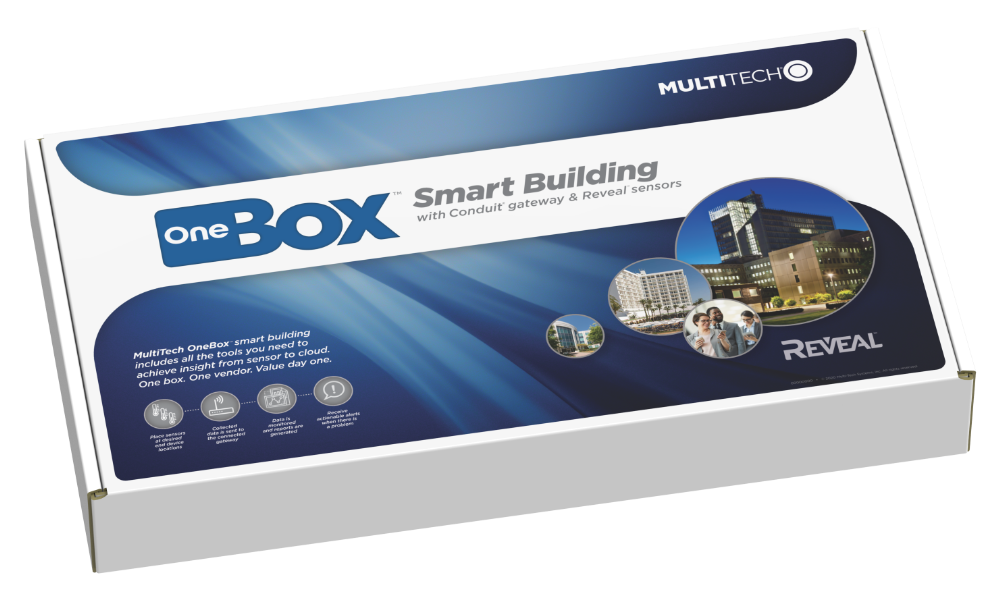Smart Buildings IoT
Managing remote properties isn’t easy – that’s why you need device-level intelligence for applications powering enterprise IoT Solutions.
In IoT building automation, real-time decisions need to be made quickly, requiring more intelligence at the network edge. The right smart building sensors are able to analyze information onsite and only send what is relevant back to the center, reducing network demands.
IoT Gateways, Routers & Modems in Smart Buildings
MultiTech OneBox™
Smart Building Kit provides everything you need to quickly evaluate LoRaWAN® technology and gain insights from sensor to cloud.
MultiTech OneBox™ Smart Building Kit provides everything needed to rapidly get your LoRaWAN sensor application up and running: sensor + gateway + cloud – all in one box.
Designed to enable you to obtain sensor information and display it in the cloud within minutes of opening the box.

Smart Buildings FAQs
Frequently Asked Questions about Smart Buildings IoT
Smart building IoT sensors are devices that collect environmental input and process that data in order to perform desired automated functions related to security, facilities management, or related property needs. Wireless MultiTech sensors that perform these functions include:
- Temperature sensors
- Proximity sensors
- Push button sensors
- Movement sensors
- Leak detection sensors
- Industrial sensors
MultiTech smart building IoT sensor technology can help lead to fewer errors, faster response times, improved compliance, decreased downtime, and ultimately, cost savings. That’s because our equipment enables:
- Wireless failover
- Wireline replacement
- Parallel networking
- Remote equipment management and control
- Facility automation
- Secure data transfer
Internet of Things (IoT) sensors are small devices that collect and share data gathered from their surroundings within a technological ecosystem. Sometimes the sensor can act on the data immediately or the data can be sent to an IoT gateway that aggregates and sends the data where it needs to go for further action and analysis.
Smart building IoT sensors are devices that collect environmental input and process that data in order to perform desired automated functions related to security, facilities management, or related property needs. Wireless MultiTech sensors that perform these functions include:
- Temperature sensors
- Proximity sensors
- Push button sensors
- Movement sensors
- Leak detection sensors
- Industrial sensors
A smart building is a facility that uses advanced technology and data analytics to optimize its operations, improve energy efficiency, and enhance the occupant experience. Smart buildings use a variety of sensors, devices, and systems to collect and analyze data on building operations, energy consumption, and occupant behavior. This data is then used to make informed decisions about building management, energy usage, and maintenance.
Smart buildings can include a wide range of systems and technologies, including:
- Building automation systems (BAS): These systems control the building’s mechanical and electrical systems, such as HVAC, lighting, and security.
- Energy management systems (EMS): These systems optimize energy usage and reduce energy waste by monitoring and controlling energy consumption.
- Occupancy sensors: These sensors detect the presence of occupants and adjust building systems accordingly, such as turning off lights in unoccupied rooms.
- Environmental sensors: These sensors monitor indoor air quality, temperature, and humidity to ensure optimal comfort and health for occupants.
- Building analytics software: This software collects and analyzes data from building systems and sensors to identify inefficiencies, optimize operations, and predict maintenance needs.
Smart buildings offer a number of benefits, including:
- Improved energy efficiency: Smart buildings can reduce energy waste by optimizing energy consumption and reducing energy usage during times of low occupancy.
- Enhanced occupant comfort and productivity: By adjusting building systems based on occupant behavior and preferences, smart buildings can create a more comfortable and productive environment for occupants.
- Predictive maintenance: Smart buildings can identify maintenance needs before they become critical, reducing downtime and improving equipment lifespan.
- Cost savings: By optimizing energy usage and reducing maintenance costs, smart buildings can result in significant cost savings over time.
Smart buildings represent a growing trend in building design and management, offering a wide range of benefits for both building owners and occupants.